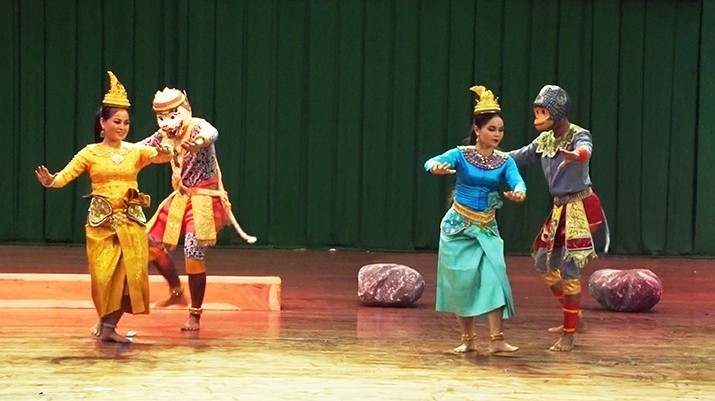Robam is a stage art blended with theatrical dance and classical drama practised by the Khmer people of the southern region, and of Tra Vinh province in particular. It is also a combination of traditional dances, beautiful singing, elaborate costumes, and the arts of masquerade masks for artists.
Characters in a Robam play are divided into two groups: the good, who don’t wear masks during the performance, and the evil, who often distinguish themselves with masks. At the end of the play, good always triumphs over evil.
Robam is practiced at traditional festivals, worshipping rituals, at ceremonies celebrating the transition from rain to sunshine, and before harvest season.
Official documents have not yet been found to trace the earliest performances of the Khmer people’s Robam stage art or who the founder of the art was. However, based on the aesthetic criteria and structure of the plays, arts researchers believe that Robam is a royal stage genre of Khmer people in the southern region dating from before the 20th century.
Surveys made by the Tra Vinh Provincial Museum have shown that the arts of Robam in Tra Vinh province reached their peak during the 1960s, with most artists and dancers being local residents.
According to Meritorious Artist Kim Thinh, former head of the Anh Binh Minh art troupe, the main language used in a Robam performance is that of dance, and the scripts are developed based on folk tales and the Ramayana - an ancient Indian epic poem.
During its golden days, Robam artists delivered their performances under torchlight on a ground space which was covered with straw.
Nowadays, stage equipment and lighting systems provide greater support for the performers in drawing audiences. Scripts have been shortened to make the performances more accessible for the audience.
However, the staging of a Robam play is a time-consuming work, requiring highly trained artists and dancers and elaborate costumes. Needless to say, the number of master artists of Robam has dwindled over time, raising an urgent call to preserve the treasured intangible cultural heritage.
In response to the call, Tra Vinh University launched a department on Khmer language, culture and arts in 2012, providing training programmes on the traditional practises and cultural values of the Khmer people.
The local authorities and the public have also become more involved in efforts to preserve and promote this unique dance of Vietnam’s southern people.
















